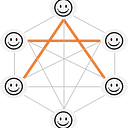Egger Mielberg
egger.mielberg@gmail.com
27.01.2019
Abstract.
As a symmetric as an asymmetric scheme requires a key (session or private) to be hidden. In this case, an attacker gets a chance and time for finding and decrypting it. As long as a secret has static attributes (length, type of characters, etc.) it will always be vulnerable for an attack.
We propose a new concept of keyless encryption, “Amorphic scheme”, which is semantically secured and has “Perfect Secrecy” level. It allows a secret to be transmitted over any public channel with no public or private key to be generated and stored.
1. Introduction
Currently there are two main schemes for encryption of data, symmetric and asymmetric.
In case of symmetric scheme, there is only one key, session key (sk), which is used in both ways, encryption and decryption of user information. The same session key must be obtained by both sides, a sender and a recipient. As soon as the sides got the key they can start messaging.
Disadvantages of symmetric scheme:
1. ”No user authentication”.
For example, if Bob wants to transmit some secret data to Alice, he will strongly need to be 100% sure that a message received back from Alice is the original one.
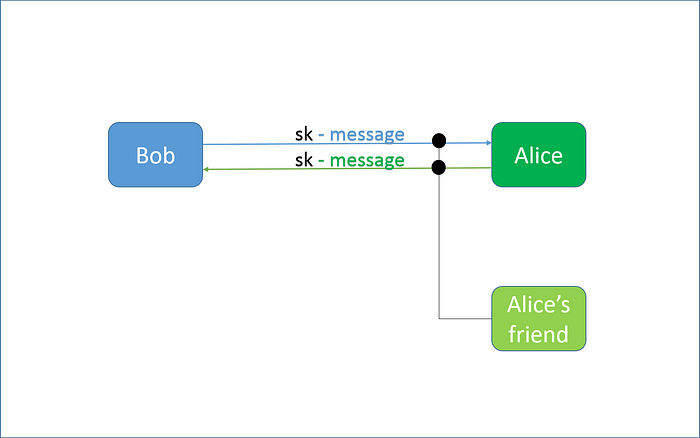
Figure above shows that the symmetric scheme does not propose a mechanism of authentication of a recipient.
2. ”Simultaneous acquisition of the key”.
In order to start exchanging data both sides, Bob and Alice need to get the same key, simultaneously.
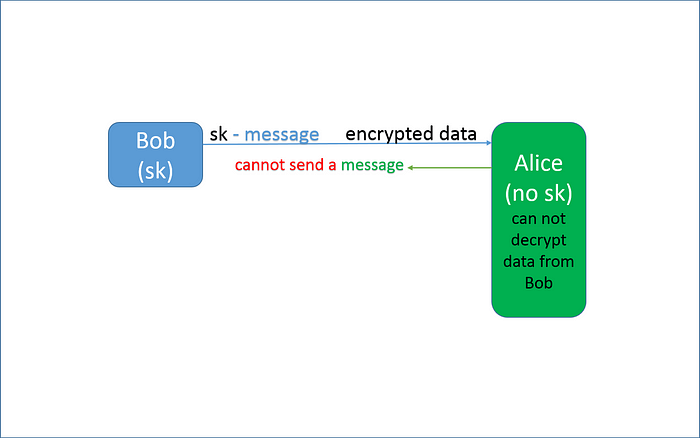
3. ”Key compromise”.
A secure storage place for the key is strongly required. As soon as the key is compromised, anyone will get a chance to masquerade as a sender as a recipient.
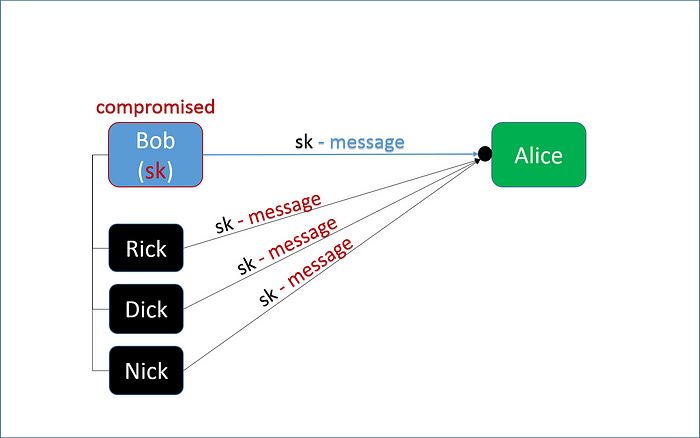
The sides must take an extra care of key storage. Ideally, the key should be duplicated and kept off site in order to protect it against robbery, program bugs, etc.
Asymmetric scheme uses two different keys, public and private. The public key is used for encryption of data. The private key is used for decryption of the data and must be stored in a private offline place.
Disadvantages of asymmetric scheme:
1. “No public key authentication”.
The public key is usually transmitted over a public channel. In case of interception, a third-party can masquerade either a sender or a recipient.
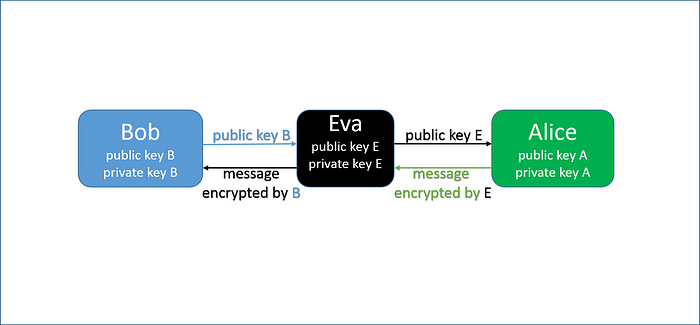
As figure above shows, Bob will never know who he is massaging to.
2. “Private key compromise”.
It is a worst case when the private key is compromised by a third-party. It means that all user data are exposed and can be lost forever.
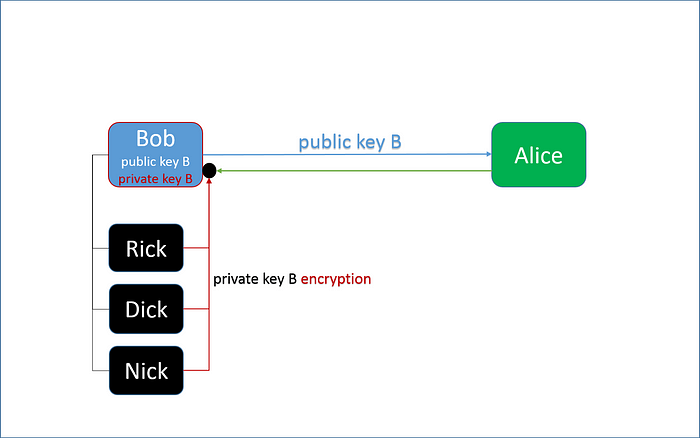
3. “Quantum computer’s thread”.
As many asymmetric schemes are based on NP-complexity of task solution, a quantum computer which is million times faster than any conventional computer can become capable of calculating the private key at some reasonable period of time.
We propose a new scheme, “Amorphic scheme”, that eliminates all the above-mentioned disadvantages. It has three main features:
1. No public key is needed for transmitting it over a public channel.
2. No private key is needed for storing it in a private encrypted place.
3. Ciphertext is transmitted in a public channel with no possibility to be deciphered by known algorithms of cryptanalysis.
2. Keyless paradigm
As soon as we create a secret we have immediately to worry about some private and secure place for it. It leads to a creation of isolated and barbed wire protected storage. In other words, we publicly yell where the secret is and state how big the wall surrounding it. In nature, we see absolutely opposite picture. Every piece of information is exposed to a research of any kind.
Keyless concept is about creation of transmission and storage of the secret without isolating it from conventional information.
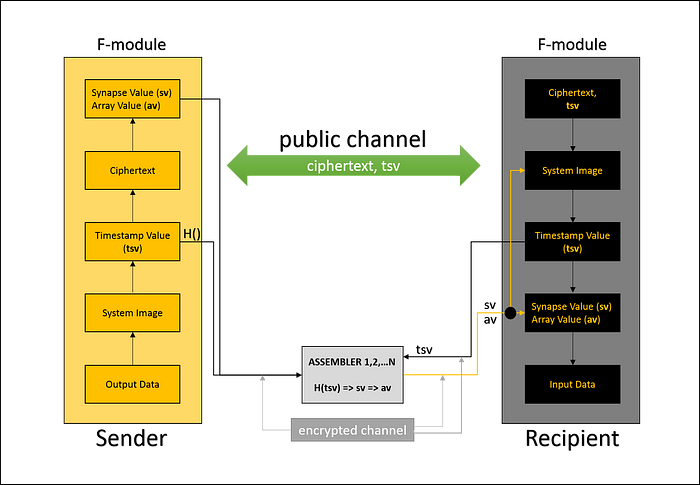
As we can see on figure above, in order to transmit a message to the recipient, the sender needs to pass four steps.
Step 1:
F-module generates a system image. The system image can include but not limited such computer system characteristics as system time, cache value, buffer value, system variable value, etc. Some values in the system can be stored in a specific system (encrypted) file.
This step is crucial for reaching a high level of security and privacy in a process of messaging between participants of Neurochain Network [2].
Step 2:
F-module gets a system time value. This value is needed for:
1. sending it on a public channel with a ciphertext.
2. using it for getting a synapse value from one of the chosen Assembler.
Step 3:
F-module launches a cryptographic algorithm [1]. In many practical cases, it is enough to use not more than 3 rounds. As a result, it generates a ciphertext of amorphic structure.
Step 4:
The cryptographic algorithm forms a synapse and array values. The array value is a part of the ciphertext which is used for deciphering and needed to be found.
The functionality of F-module can be realized by Fsp function.
Assembler is a programmable unit which can be as a local or remote module as a full-service server. It stores hash values of tsv and values of sv and av. The location of the assembler can be as permanent as changing on a per communication basis.
The system image plays an important role as for sender as for recipient. The system image is a hardware resource of entropy which includes and strongly tied to Participant Unique Number (PUN). PUN as well as system image is generated by a programmable module (application) that realizes Amorphic Encryption.
The system image has two main functions:
1. authorization of outcoming messages.
2. authorization of incoming messages.
As figure above shows, while receiving sv and av values, if the recipient is not authorized by the system image for deciphering message from the sender, it will not be granted a right to proceed any further.
High level of amorphous is reached by the following three components:
a. system image.
b. timestamp value.
c. av of NACA.
In total, using hashes of the all three components will lead to a strong random value which is dynamically generated from one message to another.
3. Level of secrecy
The level of secrecy of Amorphic Encryption can be shown and proved by elimination of the main disadvantages of both symmetric and asymmetric schemes.
“No user/key authentication”.

The authentication of participants is realized by a “one-time” tsv check during their first message in Neurochain Network. All subsequent messages between participants are regulated by Assembler which are decentralized and use only two parameters, tsv and NN. Thus, none of the participants needs to transmit neither a public key nor a private key.
“Key compromise”.
Starting from a second message, a participant will only need to send a ciphertext of the message and tsv. The ciphertext as well as tsv are always unique. For example, if a sender is attempting to send the same message for a given period of time, then each attempt will generate a unique ciphertext and unique tsv as well.
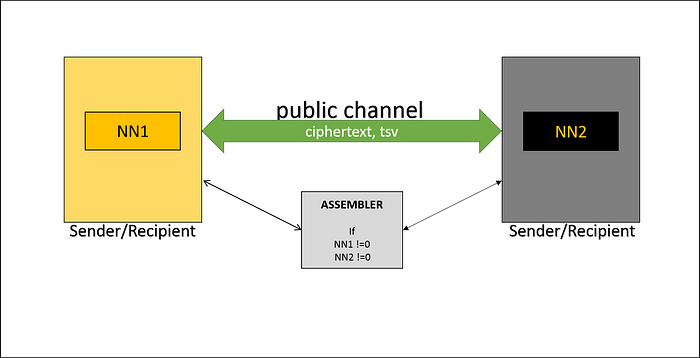
There is strict rule of formation of a message. Before any messaging, F-module (submodule) requests PUN from system memory (system file) in order to calculate a hash value of it. If the hash value is matched to the stored one then the message will be sent to a recipient.
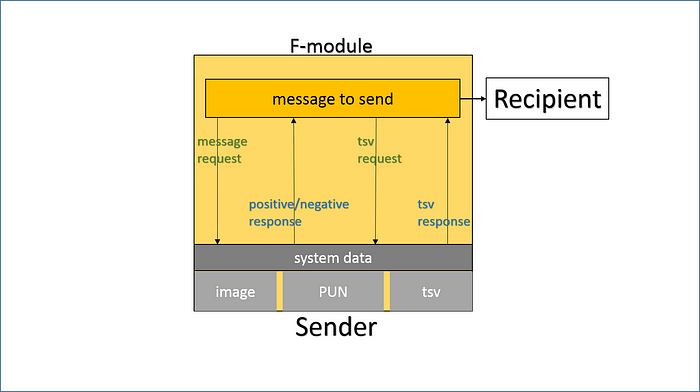
The rule was specifically designed for two security reasons:
1. the authorization process which is realized in a background mode without direct participation of a user of F-module (application).
2. inability to form and send a message by a third-party who intercepted the message or virtualized the user system.
“Quantum computer thread”.
The quantum computers are fit well for tasks with a number of iterative cycles. It is to be specially noted that only a static (constant) data allows to work with itself for some period of time. In case of dynamic data, the possibilities of the quantum computer are significantly reduced.
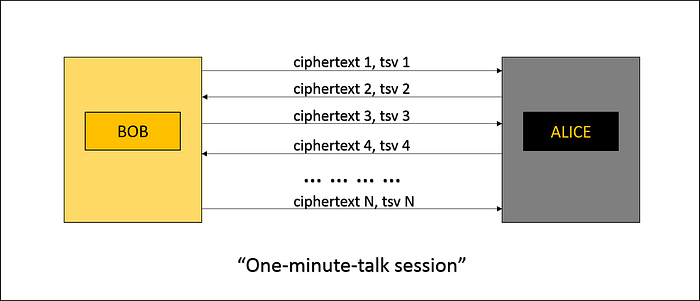
Neural Entropy [1] of each ciphertext is extremely high and makes quantum computer’s work unsuitable and meaningless.
4. Axioms of Amorphous
An encryption scheme is amorphous if and only if the following three axioms are true:
Want to continue? Read pdf-format file
